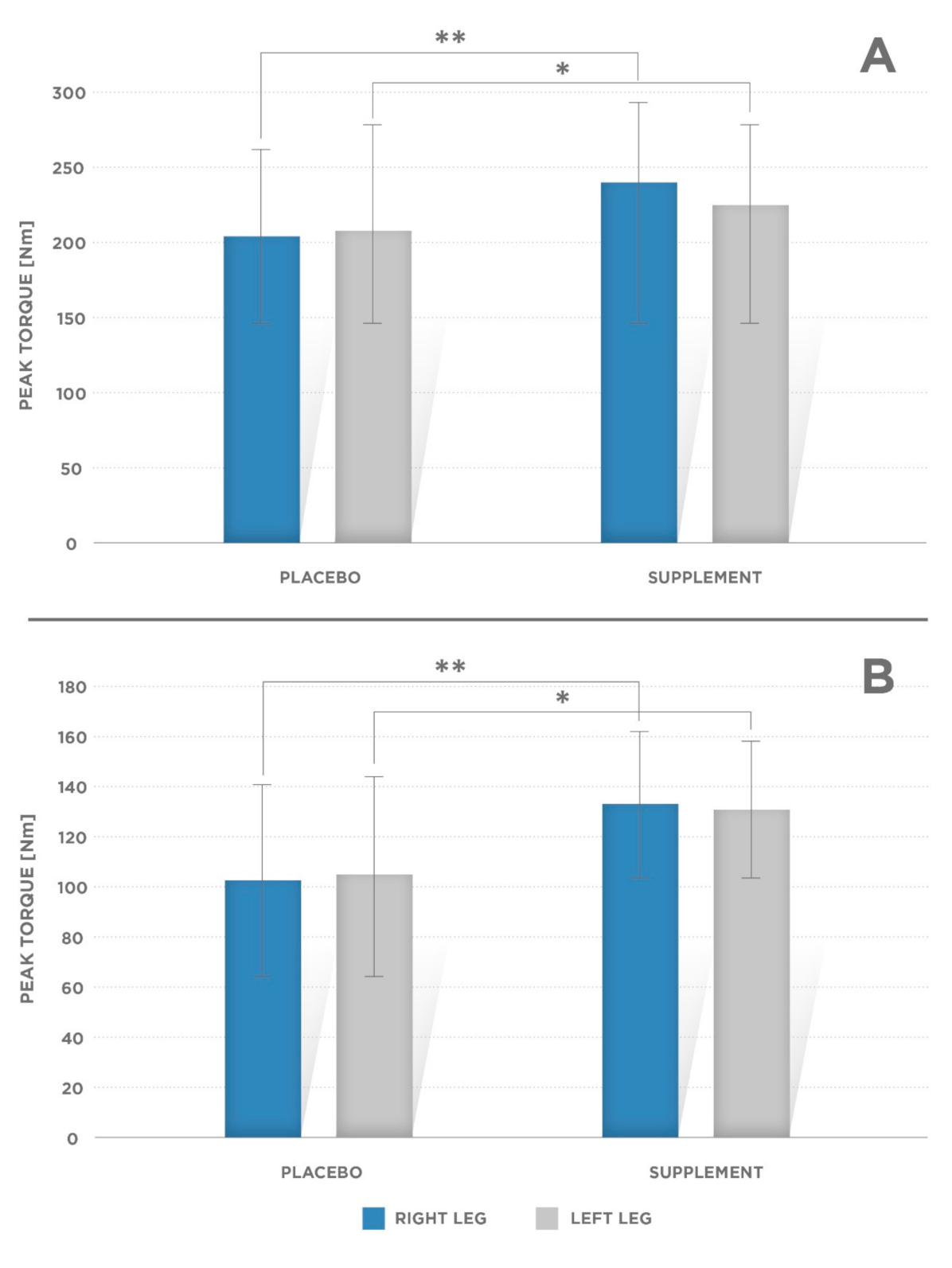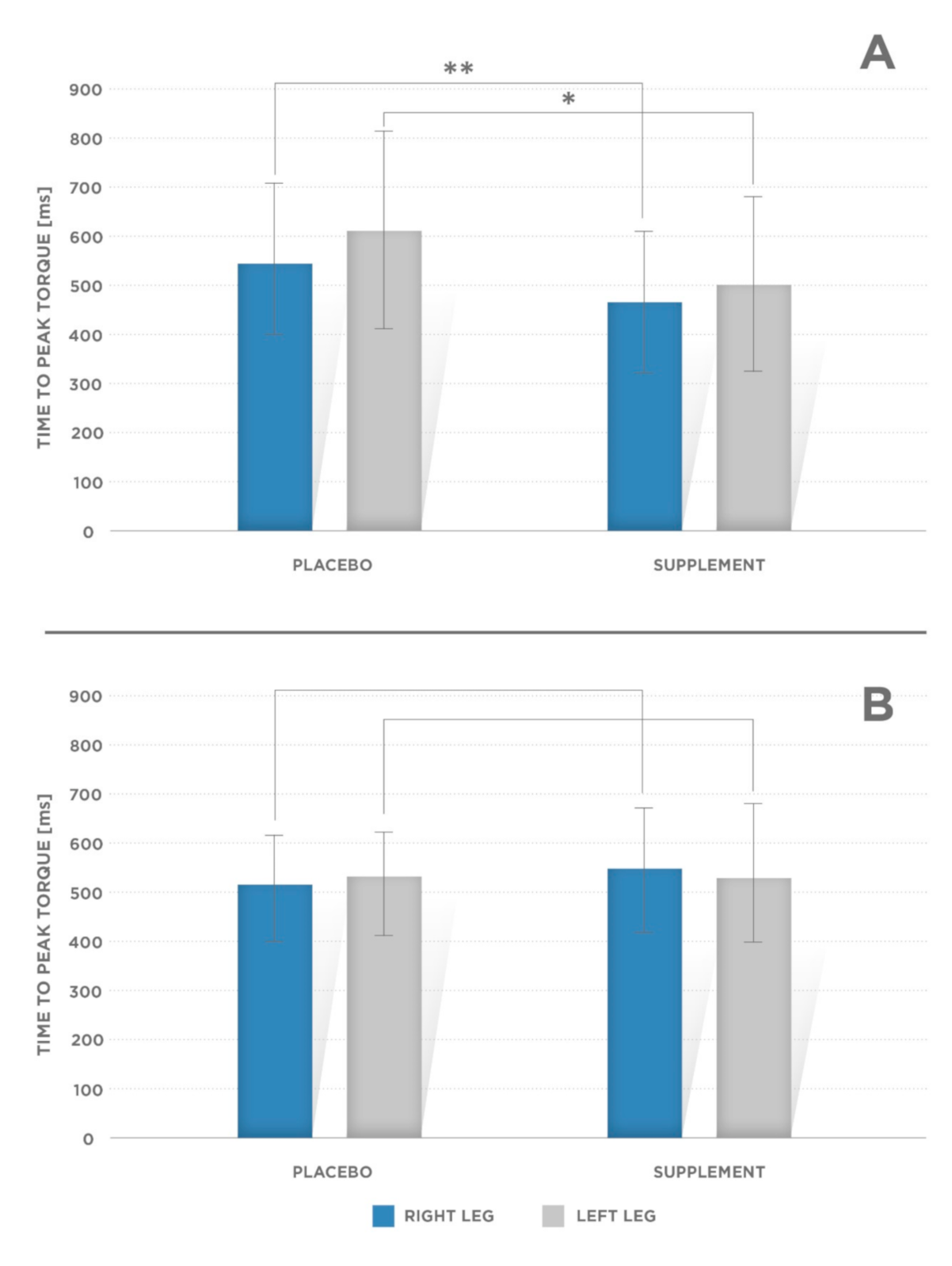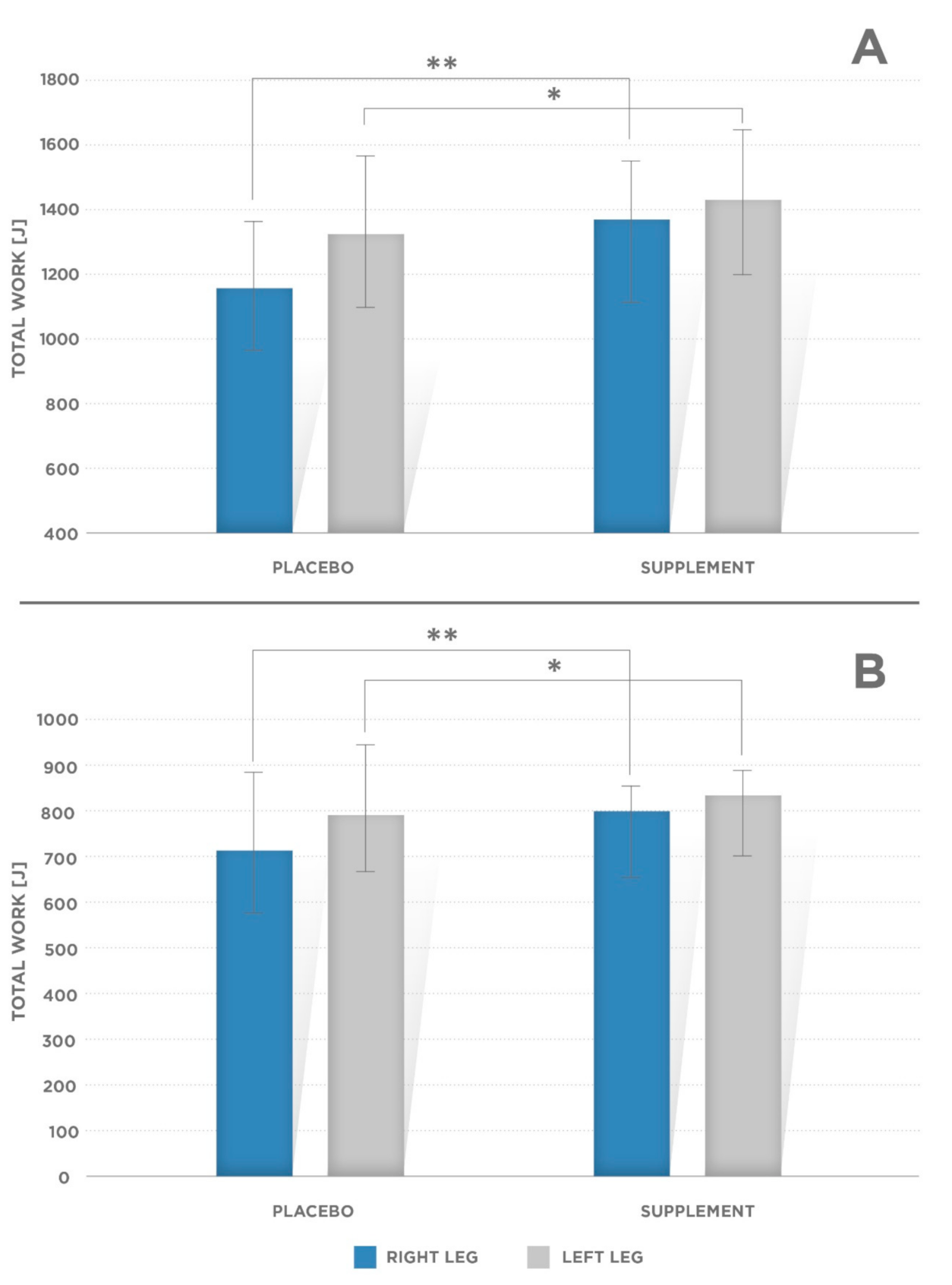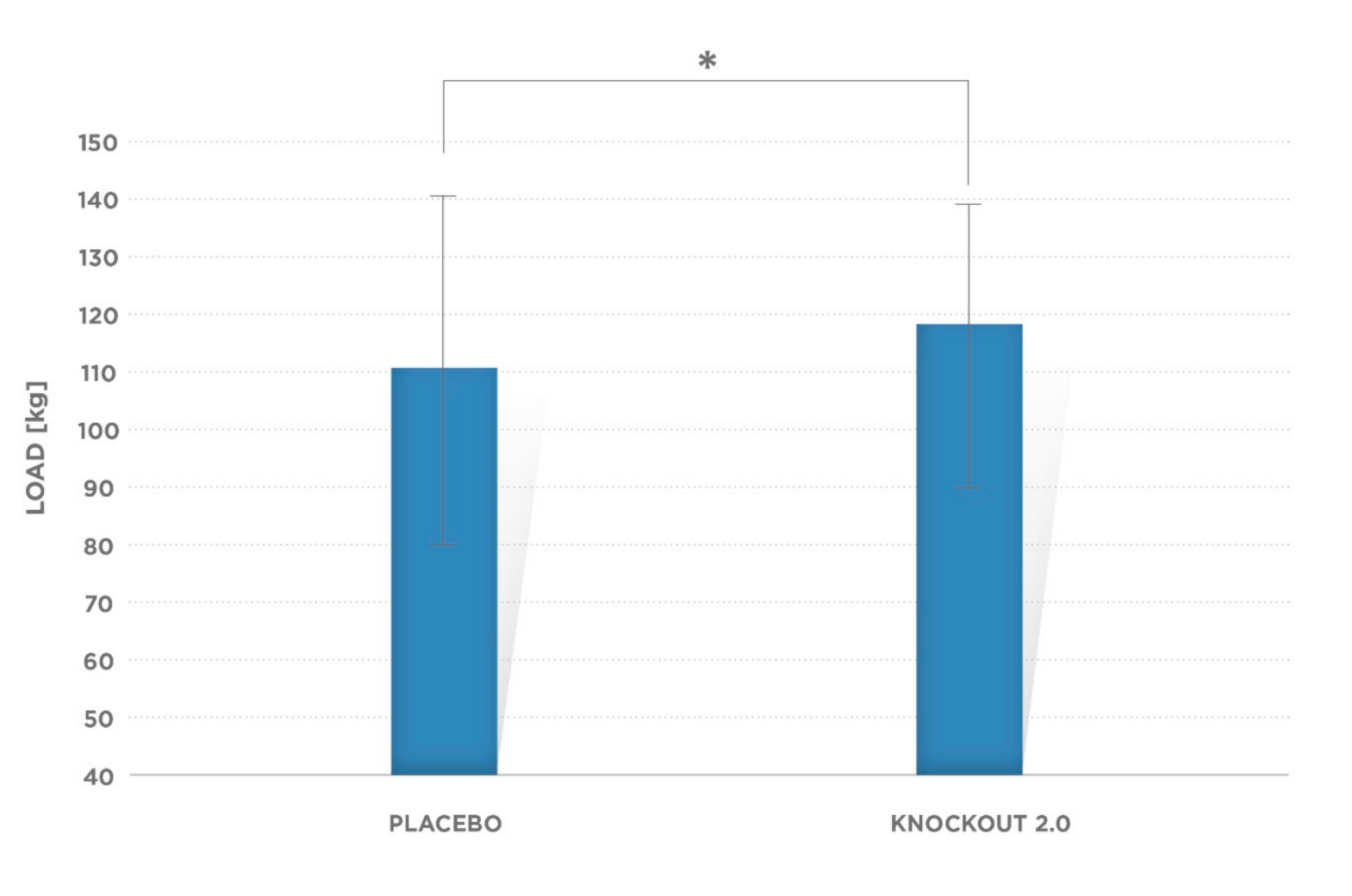Effects of Pre-Workout Multi-Ingredient Supplement on Anaerobic Performance: Randomized Double-Blind Crossover Study
Abstract
1. Introduction
2. Materials and Methods
2.1. Materials
2.2. Methods
2.3. Isokinetic Test
2.4. Maximal Strength Test
2.5. Wingate Test
2.6. Statistical Analysis
3. Results
3.1. Isokinetic Test
- Right side: PL: 202.6 ± 58.6 Nm; supplement condition: 237.2 ± 54.75 Nm (p = 0.001);
- Left side: PL: 203.3 ± 63.2 Nm, supplement condition: 229.8 ± 50.8 Nm (p = 0.002).Mean PT was significantly greater in supplement condition for knee flexors (Figure 1B):
- Right side: PL: 103.2 ± 37.6 Nm; supplement condition: 131.8 ± 29.3 Nm (p = 0.001);
- Left side: PL: 103.7 ± 39.3; supplement condition: 129.4 ± 28.4 (p = 0.001).Other mechanical variables obtained via isokinetic strength tests for the knee joint:
3.2. Maximal Strength Test
3.3. Wingate Test
4. Discussion
5. Conclusions
Author Contributions
Funding
Conflicts of Interest
References
- Thomas, D.T.; Erdman, K.A.; Burke, L.M. Position of the Academy of Nutrition and Dietetics, Dietitians of Canada, and the American College of Sports Medicine: Nutrition and Athletic Performance. J. Acad. Nutr. Diet. 2016, 116, 501–528. [Google Scholar] [CrossRef]
- Hoffman, J.R.; Ratamess, N.A.; Ross, R.; Shanklin, M.; Kang, J.; Faigenbaum, A.D. Effect of a Pre-Exercise Energy Supplement on the Acute Hormonal Response to Resistance Exercise. J. Strength Cond. Res. 2008, 22, 874–882. [Google Scholar] [CrossRef] [PubMed]
- Eudy, A.E.; Gordon, L.L.; Hockaday, B.C.; Lee, D.A.; Lee, V.; Luu, D.; Martinez, C.A.; Ambrose, P.J. Efficacy and safety of ingredients found in preworkout supplements. Am. J. Health Pharm. 2013, 70, 577–588. [Google Scholar] [CrossRef] [PubMed]
- Korczak, R.; Kruszewski, M.; Kruszewski, A.; Kuzmicki, S.; Olszewska, A.; Kepa, G.; Landowski, K. Preferences in the use of nutritional supplements and the correctness of their selection for training purposes. Balt. J. Health Phys. Act. 2016, 8, 100–108. [Google Scholar] [CrossRef]
- Jagim, A.R.; Jones, M.T.; Wright, G.A.; Antoine, C.S.; Kovacs, A.; Oliver, J.M. The acute effects of multi-ingredient pre-workout ingestion on strength performance, lower body power, and anaerobic capacity. J. Int. Soc. Sports Nutr. 2016, 13, 11. [Google Scholar] [CrossRef] [PubMed]
- Graham, T.E.; Spriet, L.L. Metabolic, catecholamine, and exercise performance responses to various doses of caffeine. J. Appl. Physiol. 1995, 78, 867–874. [Google Scholar] [CrossRef] [PubMed]
- Graham, T.E.; Hibbert, E.; Sathasivam, P. Metabolic and exercise endurance effects of coffee and caffeine ingestion. J. Appl. Physiol. 1998, 85, 883–889. [Google Scholar] [CrossRef] [PubMed]
- McLellan, T.M.; Bell, D.G. The Impact of Prior Coffee Consumption on the Subsequent Ergogenic Effect of Anhydrous Caffeine. Int. J. Sport Nutr. Exerc. Metab. 2004, 14, 698–708. [Google Scholar] [CrossRef] [PubMed]
- McNaughton, L.R.; Lovell, R.; Siegler, J.C.; Midgely, A.W.; Moore, L.; Bentley, D.J. The Effects of Caffeine Ingestion on Time Trial Cycling Performance. Int. J. Sports Physiol. Perform. 2008, 3, 157–163. [Google Scholar] [CrossRef] [PubMed]
- Astorino, T.A.; Rohmann, R.L.; Firth, K. Effect of Acute Caffeine Ingestion on One-Repetition Maximum Muscular Strength. Med. Sci. Sports Exerc. 2007, 39, S43. [Google Scholar] [CrossRef]
- Goldstein, E.R.; Ziegenfuss, T.; Kalman, D.; Kreider, R.; Campbell, B.; Wilborn, C.; Taylor, L.; Willoughby, D.; Stout, J.; Graves, B.S.; et al. International society of sports nutrition position stand: Caffeine and performance. J. Int. Soc. Sports Nutr. 2010, 7, 5–15. [Google Scholar] [CrossRef]
- Baum, M.; Weiß, M. The influence of a taurine containing drink on cardiac parameters before and after exercise measured by echocardiography. Amino Acids 2001, 20, 75–82. [Google Scholar] [CrossRef]
- Bakker, A.J.; Berg, H.M. Effect of taurine on sarcoplasmic reticulum function and force in skinned fast-twitch skeletal muscle fibres of the rat. J. Physiol. 2002, 538, 185–194. [Google Scholar] [CrossRef]
- Rutherford, J.A.; Spriet, L.L.; Stellingwerff, T. The effect of acute taurine ingestion on endurance performance and metabolism in well-trained cyclists. Int. J. Sport Nutr. Exerc. Metab. 2010, 20, 322–329. [Google Scholar] [CrossRef]
- Hobson, R.M.; Saunders, B.; Ball, G.; Harris, R.C.; Sale, C. Effects of β-alanine supplementation on exercise performance: A meta-analysis. Amino Acids 2012, 43, 25–37. [Google Scholar] [CrossRef]
- Derave, W.; Ozdemir, M.S.; Harris, R.C.; Pottier, A.; Reyngoudt, H.; Koppo, K.; Wise, J.A.; Achten, E. beta-Alanine supplementation augments muscle carnosine content and attenuates fatigue during repeated isokinetic contraction bouts in trained sprinters. J. Appl. Physiol. 2007, 103, 1736–1743. [Google Scholar] [CrossRef]
- Hill, C.A.; Harris, R.C.; Kim, H.J.; Harris, B.D.; Sale, C.; Boobis, L.H.; Kim, C.K.; Wise, J.A. Influence of beta-alanine supplementation on skeletal muscle carnosine concentrations and high intensity cycling capacity. Amino Acids 2007, 32, 225–233. [Google Scholar] [CrossRef]
- Sutton, E.E.; Coll, M.R.; Deuster, P.A. Ingestion of Tyrosine: Effects on Endurance, Muscle Strength, and Anaerobic Performance. Int. J. Sport Nutr. Exerc. Metab. 2005, 15, 173–185. [Google Scholar] [CrossRef]
- Larsen, F.J.; Schiffer, T.A.; Borniquel, S.; Sahlin, K.; Ekblom, B.; Lundberg, J.O.; Weitzberg, E. Dietary Inorganic Nitrate Improves Mitochondrial Efficiency in Humans. Cell Metab. 2011, 13, 149–159. [Google Scholar] [CrossRef]
- Tschakovsky, M.E.; Joyner, M.J. Nitric oxide and muscle blood flow in exercise. Appl. Physiol. Nutr. Metab. 2008, 33, 151–160. [Google Scholar] [CrossRef]
- Suzuki, T.; Morita, M.; Kobayashi, Y.; Kamimura, A. Oral L-citrulline supplementation enhances cycling time trial performance in healthy trained men: Double-blind randomized placebo-controlled 2-way crossover study. J. Int. Soc. Sports Nutr. 2016, 13, 6. [Google Scholar] [CrossRef] [PubMed]
- Schwedhelm, E.; Maas, R.; Freese, R.; Jung, D.; Lukacs, Z.; Jambrecina, A.; Spickler, W.; Schulze, F.; Böger, R.H. Pharmacokinetic and pharmacodynamic properties of oral L-citrulline and L-arginine: Impact on nitric oxide metabolism. Br. J. Clin. Pharmacol. 2008, 65, 51–59. [Google Scholar] [CrossRef] [PubMed]
- Sun, Q.Q.; Xu, S.S.; Pan, J.L.; Guo, H.M.; Cao, W.Q. Huperzine-A capsules enhance memory and learning performance in 34 pairs of matched adolescent students. Zhongguo yao li xue bao = Acta Pharmacol. Sin. 1999, 20, 601–603. [Google Scholar]
- Wang, R.; Yan, H.; Tang, X.-C. Progress in studies of huperzine A, a natural cholinesterase inhibitor from Chinese herbal medicine1. Acta Pharmacol. Sin. 2006, 27, 1–26. [Google Scholar] [CrossRef]
- Tang, X.C.; Han, Y. Pharmacological Profile of Huperzine A, a Novel Acetylcholinesterase Inhibitor from Chinese Herb. CNS Drug Rev. 2006, 5, 281–300. [Google Scholar] [CrossRef]
- Liang, Y.-Q.; Tang, X.-C. Comparative studies of huperzine A, donepezil, and rivastigmine on brain acetylcholine, dopamine, norepinephrine, and 5-hydroxytryptamine levels in freely-moving rats. Acta Pharmacol. Sin. 2006, 27, 1127–1136. [Google Scholar] [CrossRef] [PubMed]
- Michlig, S.; Merlini, J.M.; Beaumont, M.; Ledda, M.; Tavenard, A.; Mukherjee, R.; Camacho, S.; Le Coutre, J. Effects of TRP channel agonist ingestion on metabolism and autonomic nervous system in a randomized clinical trial of healthy subjects. Sci. Rep. 2016, 6, 20795. [Google Scholar] [CrossRef]
- Slezak, T.; Francis, P.S.; Anastos, N.; Barnett, N.W. Determination of synephrine in weight-loss products using high performance liquid chromatography with acidic potassium permanganate chemiluminescence detection. Anal. Chim. Acta 2007, 593, 98–102. [Google Scholar] [CrossRef]
- Dudhatra, G.B.; Mody, S.K.; Awale, M.M.; Patel, H.B.; Modi, C.M.; Kumar, A.; Kamani, D.R.; Chauhan, B.N. A Comprehensive Review on Pharmacotherapeutics of Herbal Bioenhancers. Sci. World J. 2012, 2012, 1–33. [Google Scholar] [CrossRef]
- Woolf, K.; Bidwell, W.K.; Carlson, A.G. The effect of caffeine as an ergogenic aid in anaerobic exercise. Int. J. Sport Nutr. Exerc. Metab. 2008, 18, 412–429. [Google Scholar] [CrossRef] [PubMed]
- Beck, T.W.; Housh, T.J.; Schmidt, R.J.; Johnson, G.O.; Housh, D.J.; Coburn, J.W.; Malek, M.H. The acute effects of a caffeine-containing supplement on strength, muscular endurance, and anaerobic capabilities. J. Strength Cond. Res. 2006, 20, 506–510. [Google Scholar]
- Morris, C.; Viriot, S.M.; Mirza, Q.U.A.F.; Morris, G.; Lynn, A. Caffeine release and absorption from caffeinated gums. Food Funct. 2019, 10, 1792–1796. [Google Scholar] [CrossRef]
- Hoffman, J.R.; Faigenbaum, A.D.; Ratamess, N.A.; Ross, R.; Kang, J.; Tenenbaum, G. Nutritional Supplementation and Anabolic Steroid Use in Adolescents. Med. Sci. Sports Exerc. 2008, 40, 15–24. [Google Scholar] [CrossRef]
- Teekachunhatean, S.; Tosri, N.; Rojanasthien, N.; Srichairatanakool, S.; Sangdee, C. Pharmacokinetics of Caffeine following a Single Administration of Coffee Enema versus Oral Coffee Consumption in Healthy Male Subjects. ISRN Pharmacol. 2013, 2013, 1–7. [Google Scholar] [CrossRef]
- Brown, L.E. Isokinetic testing and training In Isokinetics in Human Performance, 3rd ed.; Brown, L.E., Ed.; Human Kinetics: Champaign, IL, USA, 2000; pp. 358–378. [Google Scholar]
- Baechle, T.R.; Earle, R.W.; Wathen, D. Step5: Training loads and repetitions. In Essentials of Strength Training and Conditioning, 2nd ed.; Baechle, T.R., Earle, R.W., Eds.; Human Kinetics: Champaign, IL, USA, 2008; pp. 392–404. [Google Scholar]
- Bar-Or, O. The Wingate Anaerobic Test. Sports Med. 1987, 4, 381–394. [Google Scholar] [CrossRef] [PubMed]
- Bridge, C.A.; Jones, M. The effect of caffeine ingestion on 8 km run performance in a field setting. J. Sports Sci. 2006, 24, 433–439. [Google Scholar] [CrossRef]
- Bazzucchi, I.; Felici, F.; Montini, M.; Figura, F.; Sacchetti, M. Caffeine improves neuromuscular function during maximal dynamic exercise. Muscle Nerve 2011, 43, 839–844. [Google Scholar] [CrossRef]
- Pokora, I.; Wolowski, L.; Wyderka, P. The effect of a single dose of the Thermo Speed Extreme (Olimp) thermogenic supplement on circulatory functions and body temperatures at rest in male and female subjects. Balt. J. Health Phys. Act. 2019, 11, 11–25. [Google Scholar] [CrossRef]
- Behrens, M.; Mau-Moeller, A.; Weippert, M.; Fuhrmann, J.; Wegner, K.; Skripitz, R.; Bader, R.; Bruhn, S. Caffeine-induced increase in voluntary activation and strength of the quadriceps muscle during isometric, concentric and eccentric contractions. Sci. Rep. 2015, 5, 10209. [Google Scholar] [CrossRef]
- Williams, A.D.; Cribb, P.J.; Cooke, M.B.; Hayes, A. The Effect of Ephedra and Caffeine on Maximal Strength and Power in Resistance-Trained Athletes. J. Strength Cond. Res. 2008, 22, 464–470. [Google Scholar] [CrossRef]
- Álvares, T.S.; Meirelles, C.M.; Bhambhani, Y.N.; Paschoalin, V.; Gomes, P.S.; Gomes, P.P.S.C. L-Arginine as a Potential Ergogenic Aid in Healthy Subjects. Sports Med. 2011, 41, 233–248. [Google Scholar] [CrossRef]
- Bescós, R.; Sureda, A.; Tur, J.A.; Pons, A. The Effect of Nitric-Oxide-Related Supplements on Human Performance. Sports Med. 2012, 42, 99–117. [Google Scholar] [CrossRef]
- Hickner, R.C.; Tanner, C.J.; Evans, C.A.; Clark, P.D.; Haddock, A.; Fortune, C.H.; Geddis, H.E.; Waugh, W.I.; McCammon, M.I. L-citrulline reduces time to exhaustion and insulin response to a graded exercise test. Med. Sci. Sports Exerc. 2006, 38, 660–666. [Google Scholar] [CrossRef]
- Food and Drug Administration. Questions and Answers on Dietary Supplements. 2017. Available online: https://www.fda.gov/food/dietary-supplements/information-consumers-using-dietary-supplements (accessed on 15 July 2020).




| Parameter | Right Leg | Left Leg | |||||
|---|---|---|---|---|---|---|---|
| Movement | Placebo | Supplement | p | Placebo | Supplement | p | |
| TTP [ms] | FL | 548.7 ± 159.9 | 468.5 ± 141.3 | 0.002 | 615.2 ± 202.8 | 501.22 ± 170.1 | 0.002 |
| EX | 501.7 ± 123.9 | 512.1 ± 110.2 | 0.818 | 539.6 ± 119.5 | 523.52 ± 123.4 | 0.422 | |
| T@0.2 s [Nm] | FL | 103.2 ± 37.6 | 131.8 ± 29.3 | 0.001 | 103.7 ± 39.6 | 129.38 ± 28.4 | 0.001 |
| EX | 202.6 ± 58.6 | 237. 2 ± 54.8 | 0.001 | 203.3 ± 63.2 | 229.84 ± 50.8 | 0.002 | |
| Twork [J] | FL | 721.0 ± 150.2 | 798.1 ± 149.1 | 0.002 | 788.7 ± 145.1 | 843.18 ± 132.2 | 0.005 |
| EX | 1172.4 ± 188.7 | 1337.0 ± 200.1 | 0.001 | 1327.2 ± 223.0 | 1419.52 ± 205.1 | 0.002 | |
| Parameter | Placebo | Supplement | p |
|---|---|---|---|
| PP [W/kg] | 10.9 ± 0.8 | 11.1 ± 0.9 | 0.065 |
| MP [W/kg] | 8.5 ± 0.6 | 8.7 ± 0.5 | 0.038 |
| Twork [kJ] | 22.7 ± 2.7 | 23.1 ± 2.6 | 0.177 |
| FI [%] | 18.9 ± 4.0 | 19.4 ± 4.8 | 0.244 |
| Lactate concentration [mmol/L] | 14.6 ± 2.0 | 14.4 ± 1.7 | 0.873 |
Publisher’s Note: MDPI stays neutral with regard to jurisdictional claims in published maps and institutional affiliations. |
© 2020 by the authors. Licensee MDPI, Basel, Switzerland. This article is an open access article distributed under the terms and conditions of the Creative Commons Attribution (CC BY) license (http://creativecommons.org/licenses/by/4.0/).
Share and Cite
Kaczka, P.; Batra, A.; Kubicka, K.; Maciejczyk, M.; Rzeszutko-Bełzowska, A.; Pezdan-Śliż, I.; Michałowska-Sawczyn, M.; Przydział, M.; Płonka, A.; Cięszczyk, P.; et al. Effects of Pre-Workout Multi-Ingredient Supplement on Anaerobic Performance: Randomized Double-Blind Crossover Study. Int. J. Environ. Res. Public Health 2020, 17, 8262. https://doi.org/10.3390/ijerph17218262
Kaczka P, Batra A, Kubicka K, Maciejczyk M, Rzeszutko-Bełzowska A, Pezdan-Śliż I, Michałowska-Sawczyn M, Przydział M, Płonka A, Cięszczyk P, et al. Effects of Pre-Workout Multi-Ingredient Supplement on Anaerobic Performance: Randomized Double-Blind Crossover Study. International Journal of Environmental Research and Public Health. 2020; 17(21):8262. https://doi.org/10.3390/ijerph17218262
Chicago/Turabian StyleKaczka, Piotr, Amit Batra, Katarzyna Kubicka, Marcin Maciejczyk, Agata Rzeszutko-Bełzowska, Iwona Pezdan-Śliż, Monika Michałowska-Sawczyn, Marta Przydział, Artur Płonka, Paweł Cięszczyk, and et al. 2020. "Effects of Pre-Workout Multi-Ingredient Supplement on Anaerobic Performance: Randomized Double-Blind Crossover Study" International Journal of Environmental Research and Public Health 17, no. 21: 8262. https://doi.org/10.3390/ijerph17218262
APA StyleKaczka, P., Batra, A., Kubicka, K., Maciejczyk, M., Rzeszutko-Bełzowska, A., Pezdan-Śliż, I., Michałowska-Sawczyn, M., Przydział, M., Płonka, A., Cięszczyk, P., Humińska-Lisowska, K., & Zając, T. (2020). Effects of Pre-Workout Multi-Ingredient Supplement on Anaerobic Performance: Randomized Double-Blind Crossover Study. International Journal of Environmental Research and Public Health, 17(21), 8262. https://doi.org/10.3390/ijerph17218262






